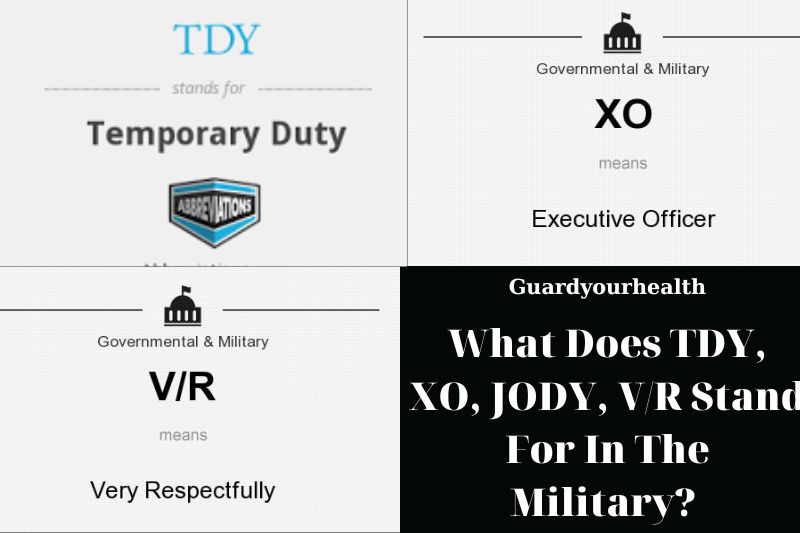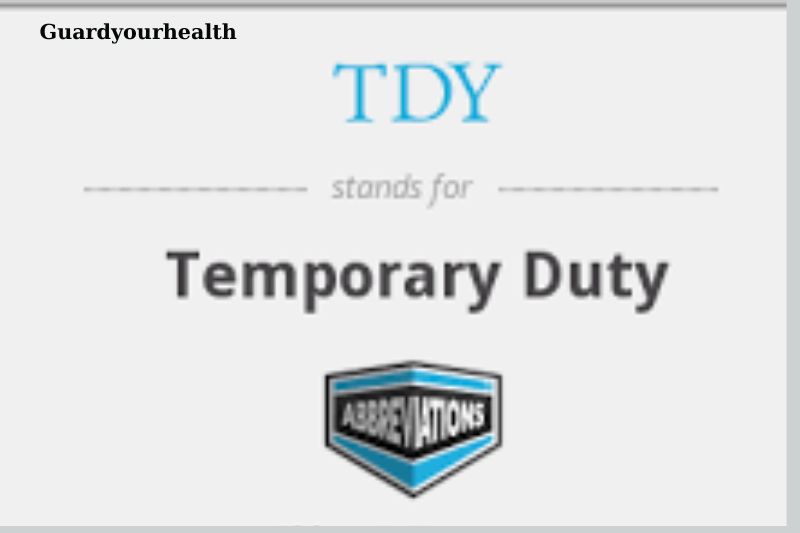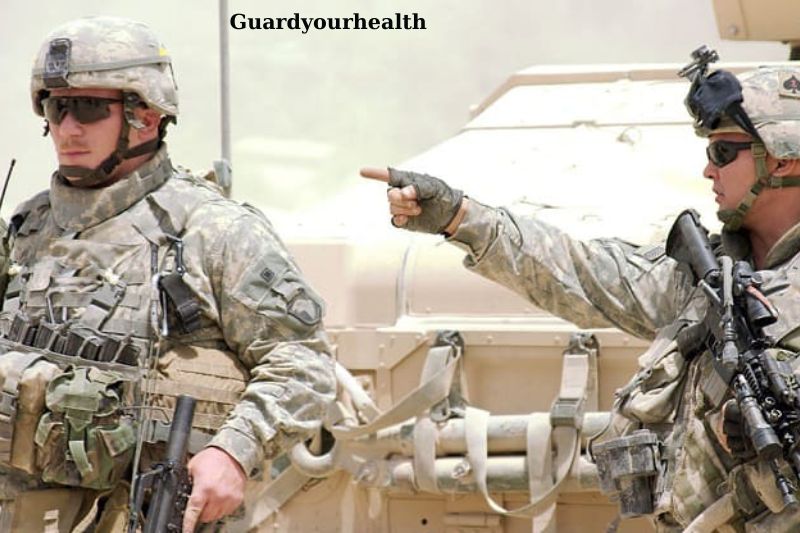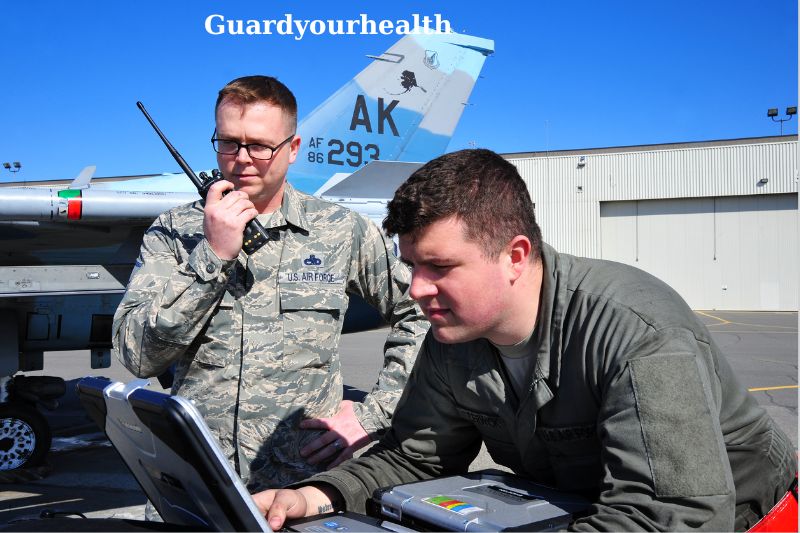In this blog, we will introduce the meanings of some common abbreviations used in the Military. “TDY” stands for “temporary duty,” “V/R” is short for “very respectfully,” “X.O.” refers to the “executive officer,” and “Jody” is the name for a soldier who stays behind while his comrades go on deployment. Let’s find out with GuardYourHealth
What Does TDY Stand For In The Military
As previously stated, TDY stands for temporary duty assignment, and it is one of three sorts of orders that military members might get throughout their service. PCS and TAD are two of the other orders. We can return to these ideas later.
Temporary duty generally refers to responsibilities performed apart from a person’s permanent or assigned duty site. TDY usually lasts up to 179 days.
TDY can be used for a variety of reasons. Here are six such scenarios:
- A soldier pursuing higher military education (Ie. The Navy Chief Petty Officer Training or Airman Leadership School)
- A member of the staff is attending a particular professional conference.
- Personnel is assigned to another site to temporarily bolster an undermanned unit.
- Personnel is deployed to another site to temporarily engage in an activity or exercise.
- A personnel flying missions from a domestic base to an overseas base.
- Moving emergency medical responders or evacuation teams to an operating site to help.
TDYs are offered in all military services. So, the answer to “What does TDY stand for in the Air Force?” is the same for the Navy, Marines, Army, and so on.
However, each branch has other order subcategories that are comparable to TDY. The Navy, for example, has TAD, which stands for temporary extra duty, while the Army has TCS, which is for a temporary change of station. The Marines also have a long-term TDY expressly for duty that lasts more than 30 days.
Nonetheless, TDY refers to temporarily allowed duty in a location other than the personnel’s assigned duty station. When the duty is completed, the employee will return to his or her original base unit of assignment.
They are required because the DoD or Department of Defense must explain any costs, per diem, or travel compensation to a certain place. The salary and allowances of personnel are also directly affected by whether or not their status is TDY.
TDY is not the same as deployment, despite its appearance. Military soldiers are allocated to a specific operation when they are deployed. Typically, it is an overseas combat operation.
For example, the United States Air Force frequently sent personnel to Afghanistan, Iraq, and Saudi Arabia for contingency missions. However, unlike TDYs, after deployment is completed, the individual returns to his or her original assigned base or duty station.
What Does XO Mean in the Military?
In the Military, an XO is a second-in-command officer or an executive officer more broadly.
The X.O. usually reports to the commanding officer, commonly known as “the first lieutenant” or “the number one.” X.O. is sometimes used to refer to “the commander” or the leader of a department inside an organization.
Personnel in these positions are often in charge of handling daily operations, aiding higher-ups, and plotting the next move of a unit.
The name “X.O.” is used in the U.S. military, not the U.K.’s. “EXO” is another term for the Indian Military. In the next part, we shall go a little more into the service of the United States X.O.s. Let’s go further into their roles!
The United States Marine Corps
The XO is the officer in charge of the battalion, squadron, battery, company, MEU, regiment, or aviation group, which includes Marine Aircraft, Marine Air Control, and Marine Wing Support. The X.O. is the wing or division commander’s assistant at a higher level. In the MEF, “X.O.” might refer to the deputy commander. However, in the MLG or MEB, “X.O.” refers to the chief of staff.
The XO is an officer who can succeed in leadership. He or she will normally be the officer in command’s rank.
Under the direct representation of the commander, all orders issued by the executive officer have the same force and effect as those issued by the commander. Simultaneously, the executive officer follows and implements the commander’s policies and instructions.
He or she must be prepared to stand in for the commander in any situation.
The United States Navy and Coast Guard
The answer to the question, “What does X.O. stand for in the Navy?” remains a second-in-command officer. There are, however, small changes in the specifics.
In the Navy and Coast Guard, the X.O. is in command of ships, shore forces, and aircraft squadrons. He or she is the “captain” in charge of all work on board, including exercises, drills, policing, inspection, personnel organization, and so on.
The X.O. provides the go-ahead for ships to launch. If the ship lacks a first lieutenant, navigator, or gunnery man, the X.O. assumes these responsibilities.
Small cutters and patrol boats are piloted by a junior officer, senior enlisted member, chief executive officer, or executive officer second-in-command of the U.S. Coast Guard.
Along with the C.O., or commanding officer, the X.O. is regarded as a naval aviator or flying officer. After 12-15 months as an X.O., an X.O. can “fleet up” to be the C.O. of a squadron.
In addition to tactical and operational duties, the X.O. is in charge of the command’s administrative officer and administrative department.
The United States Army
The XO is the command staff’s daily manager and the second in charge. Army X.O.s, like Marine Corps X.O.s, are in charge of day-to-day handling tasks such as logistics, maintenance, administration, and strategic planning.
Except when there is a deputy commander, the X.O. can step in for the commander. The chief warrant officer is known as an X.O. in some army units.
Unlike the Navy and Coast Guard, being an X.O. is not required before becoming a C.O. or commander.
The United States Air Force
X.O. is not a second-in-command position in the Air Force. Instead, it refers to a company grade officer or junior field grade officer who serves as a senior officer’s staff administrative assistant, commencing at the squadron level.
The X.O. is also known as an aide, adjutant, or executive assistant. As in the Army, becoming an X.O. is not required before advancing to a command position.
An executive officer in this context can range from a junior officer assisting a mid-ranking commander to a senior field grade assisting a general officer.
What Does V/R Mean In The Military
The V.R. email signature you see is a shortened version. It is an abbreviation for “extremely respectfully.” As a result, it is on par with “yours truly,” “sincerely,” or “much of affection” in the civilian world. The key distinction is that V/R is employed to recognize the position. This indicates that V/R is only utilized for emails sent to senior military personnel or those of the same level, not those sent to lower ranks.
When speaking with lower-level employees, emails frequently end with a lowercase “r” followed by a “/” as “/r,” which stands for “respectfully.”
Is there a significant difference in email signatures between V/R and /R?
You may believe that it is unimportant whether the final remark includes or excludes a “v”; after all, it is only one letter, right?
NO!!! In the Military, hierarchy is vitally crucial. To demonstrate your respect and follow military protocol, you must always refer to ranks appropriately.
If you only use “/r” for someone with a higher rank than you, you may appear impolite, and the receiver may take offense. This is obviously something you do not want to happen.
Is the Forward-slash in V/R and /R Required?
Furthermore, make certain that you use “V/R” or “V/r” for higher ranking receivers and “/r” for lower ranking recipients, rather than just V.R., Vr, and r. The smallest nuances matter. They demonstrate your attention to detail and seriousness, both of which are highly valued in the Military. Get your final words perfect if you don’t want to look sluggish or half-hearted.
Furthermore, without the forward-slash ‘//’), receivers may misinterpret V.R. as an acronym for virtual reality or vertical resolution, both of which are technical, technological words.
Although it is extremely unlikely, if you are unsure of the rank of your email recipient, use “V/R.”
Can I use V/R outside of emails, such as in business emails?
You now understand what V.R. means in the Military. But what about once you leave the Military? Will, your addressee, comprehend if you conclude your email with V.R.? Or will they respond with an email inquiring?
No, we believe: In civilian business emails, do not use V/R.
The acronym V/R is not widely used or understood. Even though most individuals can figure out what it means with a simple Google search, you’re actually making them work harder. As a result, unless you are certain that the person on the other end understands exactly what you mean, we do not advocate using V/R as your closing comment or email signature.
Carrying the acronym V/R into your emails a handful of times is an honest error if you are just moving out of military life and into civilian life. However, if you have been warned that it is perplexing, you should not ignore it. Then you’ll just be known as the “V.R.” oddball at work. Or, if others understand it but have pointed out that it isn’t essential, and you continue to use it, you’ll be considered pompous.
It is preferable to use the spelled-out form “respectfully” or “very respectfully.” In this instance, the former is more formal, but the latter is less formal but still professional. It is also clear, so there is no room for misunderstanding or ambiguity.
Some V/R alternatives in business emails…
You can use any of the following “formal but not too formal” alternatives as an email signature or closing comment in your business emails instead of the spelled-out form of V/R “very respectfully” or /R “respectfully”:
- Yours faithfully,
- Yours sincerely,
- Yours truly,
- Regards,
- Best,
- All the best,
- Lots of love,
What Does the Term “Jody” Mean in the Military?
As defined in Wikipedia, “Jody” is a military cadence and a term used to call the other men that a military member’s wife or girlfriend sees or dates while her husband or boyfriend is serving. In essence, “Jody” is the man who steals a soldier’s girlfriend or wife. Aka. Mr. Steal Your Girl!
Note: The female version of a “jody” is “Jodie.”
But why “Jody”?
Jody takes after a recurring, fictional character in military cadences. Jody is a civilian character who lives a luxurious life contrasting military members — remaining home instead of serving.
As a result, Jody is generally depicted as lacking military qualities and attributes, such as being physically unfit. While the soldier is away, Jody will “woo” his girl, drive his car, and effectively take his place. Usually, the “girl” in this story is referred to as “Susie,” the soldier’s sweetheart.
Hence, he is dubbed the guy everybody knows but nobody wants to meet.
The Term “Jody” in Military Cadences.
As mentioned earlier, the term “Jody” is used in military cadences, which is the time, beat, or rhythm that the Army uses to keep the stepping and marching timely.
Aside from that, singing a cadence while marching or running assists soldiers in keeping their heads up, taking consistent breaths, and exhaling forcefully. This pumps oxygen to their lungs and gives their body more energy.
As a result, the military unit (on the whole) is better prepared and healthier.
Many cadences are structured as a call and response dialogue. One soldier initiates a line, and the rest of the soldiers replies, thus, completing the call.
These military cadences are also referred to as jodies or jody calls.
Jody calls are used across the branches. However, they are not officially taught in institutions. Plus, they do not appear in the FM 3-21.5, Drill and Ceremonies Field Manual. Nevertheless, some military leaders tolerate and even encourage them.
FAQs
1. Who is Jodi Navy?
As a meteorologist for the U.S. Navy, Jodi has served in leadership, academic, and executive support roles. She is a graduate of the U.S. Naval Academy and received her Doctorate from the Naval Postgraduate School. Jodi is currently transitioning from active duty to beginning her private sector career.
2. Who is the X.O. in the Navy?
In the Military, X.O. refers to a second-in-command officer, or more generally, an executive officer. The X.O. typically reports to the commanding officer, who also goes by the names “the first lieutenant” and “the number one”. Sometimes, X.O. is a way of calling “the commander” or a head of a department in the organization.
3. What is V.R. in the signature?
V/R – Reader Andee Howard Cui explains that this stands for “Very respectfully.” The phrase has a nice sentiment, and it’s rendered less formal by the abbreviation, but I think it’s too obscure
4. How long can you go TDY?
Long-term TDY is considered to be any temporary duty longer than 30 days. “So, for travel from 31 to 180 days, you will receive a flat-rate per diem of 75 percent. For travel greater than 180 days, you will receive a flat-rate per diem for 55 percent,” Harvey Johnson explained in a DoD News interview.
Conclusion
We hope that you found these tips useful! If so, please share this tutorial with your friends and colleague. Thank you for taking the time to read











